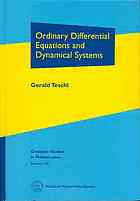
Ordinary differential equations and dynamical systems PDF
Preview Ordinary differential equations and dynamical systems
Ordinary Differential Equations and Dynamical Systems Gerald Teschl Graduate Studies in Mathematics Volume 140 American Mathematical Society Ordinary Differential Equations and Dynamical Systems Gerald Teschl Graduate Studies in Mathematics Volume 140 American Mathematical Society Providence, Rhode Island EDITORIAL COMMITTEE David Cox (Chair) Daniel S. Freed Rafe Mazzeo Gigliola Staffilani 2010 Mathematics Subject Classification. Primary 34-01, 37-01. For additional informationand updates on this book, visit www.ams.org/bookpages/gsm-140 Library of Congress Cataloging-in-Publication Data Teschl,Gerald,1970– Ordinarydifferentialequationsanddynamicalsystems/GeraldTeschl. p.cm. —(Graduatestudiesinmathematics;v.140) Includesbibliographicalreferencesandindex. ISBN978-0-8218-8328-0(alk.paper) 1.Differentialequations—Textbooks. 2.Dynamics—Textbooks. I.Title. QA371.T43 2011 515(cid:2).352—dc23 2012015024 Copying and reprinting. Individual readers of this publication, and nonprofit libraries actingforthem,arepermittedtomakefairuseofthematerial,suchastocopyachapterforuse in teaching or research. Permission is granted to quote brief passages from this publication in reviews,providedthecustomaryacknowledgmentofthesourceisgiven. Republication,systematiccopying,ormultiplereproductionofanymaterialinthispublication is permitted only under license from the American Mathematical Society. Requests for such permissionshouldbeaddressedtotheAcquisitionsDepartment,AmericanMathematicalSociety, 201 Charles Street, Providence, Rhode Island 02904-2294 USA. Requests can also be made by [email protected]. (cid:2)c 2012bytheAmericanMathematicalSociety. Allrightsreserved. TheAmericanMathematicalSocietyretainsallrights exceptthosegrantedtotheUnitedStatesGovernment. PrintedintheUnitedStatesofAmerica. (cid:2)∞ Thepaperusedinthisbookisacid-freeandfallswithintheguidelines establishedtoensurepermanenceanddurability. VisittheAMShomepageathttp://www.ams.org/ 10987654321 171615141312 To Susanne, Simon, and Jakob Contents Preface ix Part 1. Classical theory Chapter 1. Introduction 3 §1.1. Newton’s equations 3 §1.2. Classification of differential equations 6 §1.3. First-order autonomous equations 9 §1.4. Finding explicit solutions 13 §1.5. Qualitative analysis of first-order equations 20 §1.6. Qualitative analysis of first-order periodic equations 28 Chapter 2. Initial value problems 33 §2.1. Fixed point theorems 33 §2.2. The basic existence and uniqueness result 36 §2.3. Some extensions 39 §2.4. Dependence on the initial condition 42 §2.5. Regular perturbation theory 48 §2.6. Extensibility of solutions 50 §2.7. Euler’s method and the Peano theorem 54 Chapter 3. Linear equations 59 §3.1. The matrix exponential 59 §3.2. Linear autonomous first-order systems 66 §3.3. Linear autonomous equations of order n 74 v vi Contents §3.4. General linear first-order systems 80 §3.5. Linear equations of order n 87 §3.6. Periodic linear systems 91 §3.7. Perturbed linear first-order systems 97 §3.8. Appendix: Jordan canonical form 103 Chapter 4. Differential equations in the complex domain 111 §4.1. The basic existence and uniqueness result 111 §4.2. The Frobenius method for second-order equations 116 §4.3. Linear systems with singularities 130 §4.4. The Frobenius method 134 Chapter 5. Boundary value problems 141 §5.1. Introduction 141 §5.2. Compact symmetric operators 146 §5.3. Sturm–Liouville equations 153 §5.4. Regular Sturm–Liouville problems 155 §5.5. Oscillation theory 166 §5.6. Periodic Sturm–Liouville equations 175 Part 2. Dynamical systems Chapter 6. Dynamical systems 187 §6.1. Dynamical systems 187 §6.2. The flow of an autonomous equation 188 §6.3. Orbits and invariant sets 192 §6.4. The Poincar´e map 197 §6.5. Stability of fixed points 198 §6.6. Stability via Liapunov’s method 201 §6.7. Newton’s equation in one dimension 203 Chapter 7. Planar dynamical systems 209 §7.1. Examples from ecology 209 §7.2. Examples from electrical engineering 215 §7.3. The Poincar´e–Bendixson theorem 220 Chapter 8. Higher dimensional dynamical systems 229 §8.1. Attracting sets 229 §8.2. The Lorenz equation 234 Contents vii §8.3. Hamiltonian mechanics 238 §8.4. Completely integrable Hamiltonian systems 243 §8.5. The Kepler problem 247 §8.6. The KAM theorem 250 Chapter 9. Local behavior near fixed points 255 §9.1. Stability of linear systems 255 §9.2. Stable and unstable manifolds 257 §9.3. The Hartman–Grobman theorem 264 §9.4. Appendix: Integral equations 270 Part 3. Chaos Chapter 10. Discrete dynamical systems 281 §10.1. The logistic equation 281 §10.2. Fixed and periodic points 284 §10.3. Linear difference equations 287 §10.4. Local behavior near fixed points 288 Chapter 11. Discrete dynamical systems in one dimension 293 §11.1. Period doubling 293 §11.2. Sarkovskii’s theorem 296 §11.3. On the definition of chaos 297 §11.4. Cantor sets and the tent map 300 §11.5. Symbolic dynamics 303 §11.6. Strange attractors/repellers and fractal sets 309 §11.7. Homoclinic orbits as source for chaos 313 Chapter 12. Periodic solutions 317 §12.1. Stability of periodic solutions 317 §12.2. The Poincar´e map 319 §12.3. Stable and unstable manifolds 321 §12.4. Melnikov’s method for autonomous perturbations 324 §12.5. Melnikov’s method for nonautonomous perturbations 329 Chapter 13. Chaos in higher dimensional systems 333 §13.1. The Smale horseshoe 333 §13.2. The Smale–Birkhoff homoclinic theorem 335 §13.3. Melnikov’s method for homoclinic orbits 336 viii Contents Bibliographical notes 341 Bibliography 345 Glossary of notation 349 Index 351 Preface About When you publish a textbook on such a classical subject the first ques- tion you will be faced with is: Why another book on this subject? Ev- erything started when I was supposed to give the basic course on Ordinary DifferentialEquationsinSummer2000. (Atthattimethecoursemet5hours perweek.) Whilethereweremanygoodbooksonthesubjectavailable,none ofthemquitefitmyneeds. Iwantedaconcisebutrigorousintroductionwith full proofs that also covered classical topics such as Sturm–Liouville bound- ary value problems, differential equations in the complex domain, as well as modern aspects of the qualitative theory of differential equations. The course was continued with a second part on Dynamical Systems and Chaos in Winter 2000/01, and the notes were extended accordingly. Since then the manuscript has been rewritten and improved several times according to the feedback I got from students over the years when I redid the course. Moreover, since I had the notes on my homepage from the very beginning, this triggered a significant amount of feedback as well, from students who reported typos, incorrectly phrased exercises, etc., to colleagues who re- ported errors in proofs and made suggestions for improvements, to editors who approached me about publishing the notes. All this interest eventually resultedinaChinesetranslationofanearlierversionofthebook. Moreover, if you google for the manuscript, you can see that it is used at several places worldwide, linked as a reference at various sites, including Wikipedia. Fi- nally,GoogleScholarwilltellyouthatitisevencitedinseveralpublications. Hence I decided that it was time to turn it into a real book. ix
